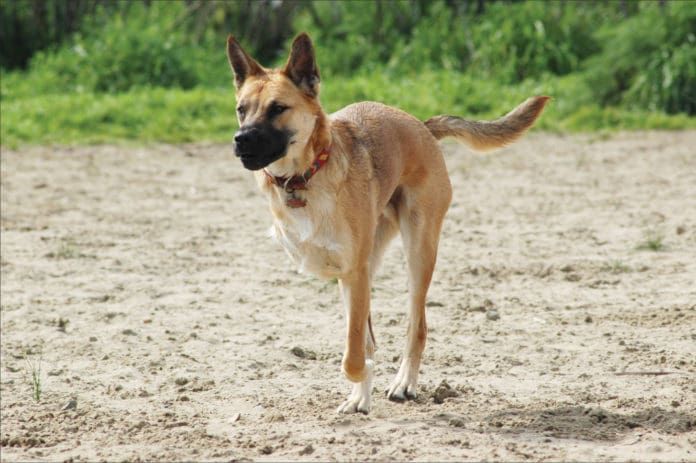Osteosarcoma is by far the most common form of bone cancer in dogs. About 75 to 85 percent of tumors occur on the legs, but can develop in any bone. Middle-aged and older large- and giant-breed dogs are most commonly affected. The first sign is usually limping, which may start suddenly, or develop gradually, and is often accompanied by swelling at the tumor site. Within one to three months, the pain will be constant, and the tumor can cause the bone to fracture. Radiographs (x-rays) are usually all that is needed to confirm the diagnosis.
Because osteosarcoma has already metastasized (spread) in 90 to 95 percent of cases before it is discovered, treatment is aimed at prolonging life and improving quality of life, primarily by reducing pain. Surgery is the first line of treatment, including amputation of the limb, if practical. Surgery is rarely curative, but amputation leaves the dog pain-free to enjoy life for a time. Chemotherapy following surgical removal can prolong that time. Palliative therapies such as radiation are used for pain relief, especially when amputation is not an option. Drugs called bisphosphonates can be tried to inhibit bone destruction and relieve pain.
About half of dogs treated with surgery and chemotherapy will live for at least one year, and up to half of those will be alive after two years; occasionally, some dogs will be completely cured. Dogs treated only with amputation or palliative radiation therapy live on average about six months after diagnosis.
Now, new therapies are emerging that offer hope for prolonged life. Dr. Nichola Mason, an assistant professor at the University of Pennsylvania School of Veterinary Medicine, is conducting clinical trials using immunotherapy to treat dogs with osteosarcoma.
Immunotherapy is the term used for vaccines that stimulate the dog’s own immune system to destroy cancer cells. The vaccine Dr. Mason is using consists of genetically modified bacteria designed to express a tumor marker known as “Her2/neu,” which is also expressed in approximately 40 percent of canine osteosarcomas, as well as other types of cancers. If the vaccine triggers the immune system to attack the bacteria, the expectation is that it will then go on to seek out and eliminate any tumor cells remaining after chemotherapy. The vaccine is given intravenously once a week for three weeks following amputation and chemotherapy. As of this writing, 12 dogs have been treated with the vaccine therapy. Side effects have been minimal, consisting primarily of short-term fever and sometimes nausea.
Of the first six dogs who received the vaccine, one dog who received a low dose of the vaccine had developed lung metastases, while the other five remained free of cancer a year later. Three of those dogs remained alive and cancer-free in November 2013, 500 or more days after initial therapy.
Dr. Mason hopes to include dogs unable to undergo amputation in future trials. She is also looking at the possibility of using the vaccine to prevent osteosarcoma in certain breeds at particularly high risk of the disease.
Palladia (toceranib phosphate), a drug approved in 2009 for treatment of mast cell cancer, has also shown promise in treating osteosarcoma. Studies are currently underway at Colorado State University and the University of Pennsylvania to evaluate the effectiveness of toceranib for the treatment of dogs with osteosarcoma.
Another clinical trial using targeted treatment for canine osteosarcoma in dogs is being conducted in Portland, Oregon. Doctors at the Keller Laboratory at Oregon Health and Science University have teamed with veterinarians at Oregon State University and Colorado State University to study osteosarcoma treatment in dogs, hoping it will lead to better treatment for children with this disease. The goal is to develop personalized treatment by testing dozens of drugs on a tumor to determine which is most effective for that individual. Wally, the first dog treated in this manner, survived for 29 months after his treatment. Dr. Keller hopes to find more than 40 dogs with osteosarcoma to participate in the clinical trial.
For more information:
Canine cancer studies at the University of Pennsylvania:
tinyurl.com/vet-upenn-studies
tinyurl.com/vet-upenn-trials
Canine cancer studies at the University of Colorado:
tinyurl.com/vet-colo-trials
Canine cancer studies at the OHSU’s Keller Laboratory:
tinyurl.com/vet-kellerlab






